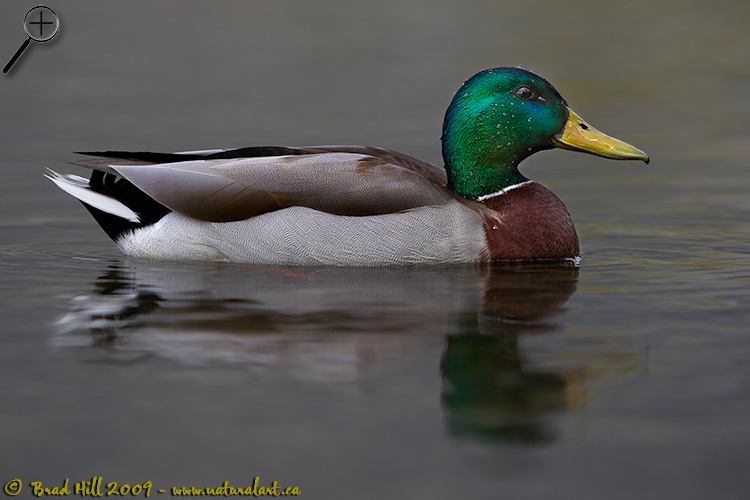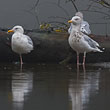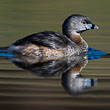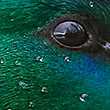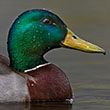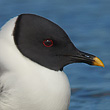Availability: Undetermined - Enquiries?
In the Field
Mallard - Common Bird, Uncommon Beauty. Haynes Point Provincial Park, Osoyoos, BC. April 21, 2009.
This mallard image is the full-frame version of the portrait presented in "Part 1" of this image pair. As previously mentioned, I shot this image under lightly overcast sky and with relatively diffuse lighting. This is pretty much my favourite lighting for showing the detail and nuances of bird plumage (and mammal pelages). The duck had been doing what ducks do - dabbling for aquatic invertebrates and other food sources just under the water - which gave me the those great water droplets to work with.
One of my favourte things to do as a nature photographer is to work with very common and familiar species and present them "in a new light" (so to speak). It doesn't matter what species you're working with, be it a squirrel, "gopher", house sparrow or "plain old mallard", the same principle applies: the BEST photo of that species is yet to be taken (and once it is taken, it won't be best for long!).
Working repeatedly with common, readily available species has several benefits. First, you can never be too familiar with your camera and its controls. The only way to get totally comfortable with all your camera's controls and functions is through practice, practice, and more practice. And, it's best done when you're working with a living, breathing, and MOVING subject. There's no better way to master your exposure compensation decisions and the nuances of your camera's autofocus system(s) than to photograph live subjects in a field setting.
Second, after shooting four or five thousand shots of a Red Squirrel you'll get over the thrill of simply getting close to the subject and the sound of your shutter (regardless of how cool it sounds at 9 fps). Soon you'll find yourself looking at the subject more critically and begin to critically evaluate the light, the colour, the subtleties of specific poses, etc. And only then will you begin to start taking really good shots of that subject. And, soon this critical eye will begin to carry over to ALL your subjects - so the next time you run into that Grizzly Bear, Gray Wolf, Orca, or whatever, you'll be ready to look at it critically and begin capturing top-notch shots right away.
So...don't waste any time you have between those rare sessions of working with the "charismatic megafauna" - get out there and chase down your local squirrel (or whatever) and start shooting!
Behind the Camera
Mallard - Common Bird, Uncommon Beauty. Haynes Point Provincial Park, Osoyoos, BC. April 21, 2009.
Digital Capture; Compressed RAW (NEF) 14-bit format; ISO 200.
Nikon D700 with Nikon 200-400 mm f/4G ED-IF AF-S VR lens @ 400 mm supported on Gitzo G1228 Mk2 Mountaineer carbon fibre tripod with Acratech Ultimate ballhead. VR turned to "On" and in "Normal" mode.
1/125s @ f5.6; -0.33 stop compensation from matrix-metered exposure setting.
At the Computer
Mallard - Common Bird, Uncommon Beauty. Haynes Point Provincial Park, Osoyoos, BC. April 21, 2009.
RAW Conversion to 16-bit TIFF, including first-pass/capture sharpening and shadow/highlight adjustments using Phase One's Capture One Pro 4.7. Five RAW conversions at different exposure settings - ranging from -1 stop (for surrounding water) through to +1.75 stops (for portions of the flank and head region).
Further digital corrections on 16-bit TIFF file using Adobe's Photoshop CS4. Adjustments included compositing and masking of 5 exposure versions, selective colour saturation and desaturation, selective exposure curve adjustment, and selective sharpening for web output.
Conservation
Mallard - Common Bird, Uncommon Beauty. Haynes Point Provincial Park, Osoyoos, BC. April 21, 2009.
Ten percent of the revenue generated by this image will be donated to Wildsight.
Species Status in Canada*: This species is not designated as at risk.
The Mallard (Anas platyrhynchos) is the most abundant duck species in North America. In many respects it is the standard against which all other duck species are compared and is what many people think of when the work "duck" is mentioned.
The widespread distribution and huge numbers of Mallards in North America is a testament to its adaptability to diverse habitats, its ability to withstand cold climates, its acceptance of a wide variety of food types, and its tolerance of humans. In 2000 it was estimated that there were over 10 million Mallards in the mid-continent regions of North America. Each year roughly 20-25% of the autumn population of Mallards is harvested by hunters, which represents roughly 40% of the total kill of all waterfowl.
While Mallards are not considered at threat, many ecosystems within the Columbia Valley face development pressure, including wetlands critical to the local survival of Mallards. Wildsight is an effective conservation organization that protects biodiversity and promotes sustainable communities in Canada's Columbia and Rocky Mountains. Support for Wildsight, through donation or becoming a member, will help ensure that they remain effective in their efforts to conserve threatened or endangered species and ecosystems.
*as determined by COSEWIC: The Committee on the Status of Endangered Wildlife in Canada













